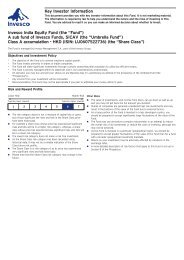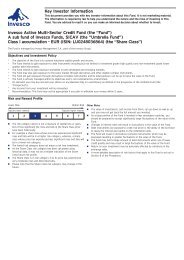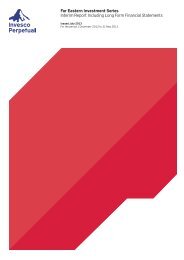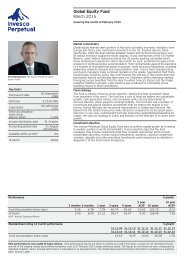Annual report: Period Ended 31 December 2012 - Invesco Perpetual
Annual report: Period Ended 31 December 2012 - Invesco Perpetual
Annual report: Period Ended 31 December 2012 - Invesco Perpetual
Create successful ePaper yourself
Turn your PDF publications into a flip-book with our unique Google optimized e-Paper software.
City Merchants High Yield Trust Limited 49<br />
18. Financial Instruments<br />
The Company’s financial instruments comprise its investment portfolio (as shown on pages 10 to 13),<br />
cash, borrowings, other receivables and other payables that arise directly from its operations such as<br />
sales and purchases awaiting settlement, derivatives and accrued income. The accounting policies in<br />
note 2 include criteria for the recognition and the basis of measurement applied for financial<br />
instruments. Note 2 also includes the basis on which income and expenses arising from financial<br />
assets and liabilities are recognised and measured.<br />
The principal risks that the Company faces in its portfolio management activities are set out below:<br />
Market risk – arising from fluctuations in the fair value or future cash flows of a financial instrument<br />
because of changes in market prices. Market risk comprises three types of risk: currency risk, interest<br />
rate risk and other price risk:<br />
Currency risk –<br />
arising from fluctuations in the fair value or future cash flows of a financial<br />
instrument because of changes in foreign exchange rates;<br />
Interest rate risk – arising from fluctuations in the fair value or future cash flows of a financial<br />
instrument because of changes in market interest rates; and<br />
Other price risk – arising from fluctuations in the fair value or future cash flows of a financial<br />
instrument for reasons other than changes in foreign exchange rates or<br />
market interest rates.<br />
Liquidity risk – arising from any difficulty in meeting obligations associated with financial liabilities.<br />
Credit risk – arising from financial loss for a company where the other party to a financial<br />
instrument fails to discharge an obligation.<br />
Risk Management Policies and Procedures<br />
The Directors have delegated to the Manager the management of the day-to-day investment activities,<br />
borrowings and hedging of the Company as more fully described in the Report of the Directors.<br />
As an investment company, investments include, but are not restricted to loan stocks, corporate<br />
bonds, government stocks, preference shares and equities held for the long-term so as to comply with<br />
its Investment Policy (incorporating the Company’s investment objective). In pursuing its investment<br />
objective, the Company is exposed to a variety of risks that could result in either a reduction in the<br />
Company’s net assets or a reduction of the profits available for dividends. The risks applicable to the<br />
Company and the policies the Company uses to manage these risks for the period under review<br />
follow.<br />
Market Risk<br />
As described on pages 22 to 23 in the Report of the Directors, high-yield fixed-interest securities are<br />
subject to a variety of risks. Many of the Company’s investments are non-investment grade securities<br />
and adverse changes in the financial position of an issuer or in the general economy may effect both<br />
the principal and the interest. Gearing by using the Company’s borrowing facility can enhance<br />
returns, however, this will also increase the Company’s exposure to market risk and volatility.<br />
The portfolio managers assess the exposure to market risk when making each investment decision,<br />
and monitor the overall level of market risk on the whole of the portfolio on an ongoing basis. Risk<br />
management is an integral part of the investment management process. The portfolio managers<br />
control risk by ensuring that the Company’s investment portfolio is appropriately diversified. In-depth<br />
and continual analysis of market and stock fundamentals give the portfolio managers the best<br />
possible understanding of the risks associated with a particular stock.

















